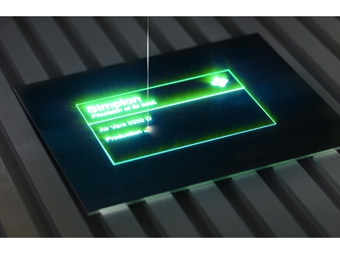Trotec is now offering the MOPA fiber laser source as an option for its SpeedMarker galvo laser marking systems. MOPA technology opens up a new world of possibilities for marking metals and plastics because it allows the user to select pulse durations (between 4 and 200 ns), which provides a much wider range of laser parameters, more options for creating high-contrast, homogeneous markings, and the ability to mark colors on some metals.
Certain plastics (especially those that are darker in color) are more difficult to mark with a conventional fiber laser, which emits pulses with relatively longer durations at a set rate. A MOPA laser can be adjusted to mark with shorter pulses that produce clearer, lighter markings with higher contrast and less burning and foaming. Using adjustable pulse durations with high peak power also subjects the material to less heat, which leads to advantages including less burning/melting in the edge area of metal engravings, less heat during annealing (which means less corrosion later), fast marking on reactive plastics, and brighter marking on dark plastics, to name a few.
The MOPA laser also offers advantages for metals, including the ability to mark (natural anodized) aluminum in black, and a faster, corrosion-free annealing marking. In general, the MOPA laser with pulse durations between 4 and 200 ns offers a wide spectrum of possibilities for marking on metals. Among other things, different annealing colors can also be produced on steel.
The selectable pulse rates provided by the MOPA also make it one of the most versatile lasers on the market. It can simulate the properties of conventional fiber lasers (relatively long pulses) and those of classical solid state lasers (relatively short pulses) such as Nd:YAG or Nd:YVO4 (vanadate).
In addition, it can produce qualitatively equivalent markings with the MOPA laser partially faster than with the conventional fiber laser.
“You can successfully mark a wide range of metals and plastics with a conventional fiber laser, but when you are working with certain metals and plastics, particularly those that are darker in color, the marking results are often less homogeneous or rich in contrast,” explains Warren Knipple, President of Trotec Laser USA. “We added the MOPA laser source to our portfolio in an effort to improve our customers’ marking results in these cases and provide them with a wider range of options.”
For more information, visit www.troteclaser.com.











